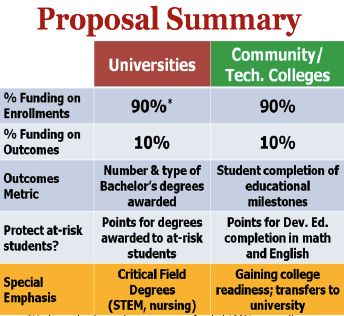
Branch Promotes Big Expansion of Performance-Based Higher Ed Funding
Above: HB 9's outcomes-based funding model. HB 25 would elevate the cap to 25 percent. Chart courtesy the Higher Education Coordinating Board.
Two years ago, Rep. Dan Branch encouraged funding higher education based on “performance” measures like four-year graduation rates. A bill passed last session called on higher education leaders to craft a new performance-based funding model, and use it for up to one tenth of their funding request this year.
Lawmakers will decide later this session whether to go ahead with funding colleges based on performance, but Branch is already moving to expand the practice. Wednesday evening, the House Higher Education committee took up his proposal to raise the cap on performance funding to one quarter of the state’s higher ed spending.
Those performance measures include the total number of bachelor’s degrees awarded and degrees awarded to at-risk students. For community colleges, measure includes the number of entry level math and English courses students finish, and the number of students completing at least 30 course hours.
Performance funding has historically been a controversial approach, but it’s spreading across the country and has support from President Obama. In Texas, it’s found a champion in Branch, the influential Dallas Republican who chairs the higher ed committee.
In a 2011 report from the Texas Center for Education Policy report, University of Texas researcher Angela Valenzuela wrote that the “outcomes” state leaders are likely to prize could leave out students who truly need more time to finish their degrees or who pursue liberal arts, humanities and other subjects that the state deems less critical. Those are precisely the areas that encourage “insightful and sophisticated decision makers,” she wrote. Discouraging them would amount to “potentially compromising the state goal of economic productivity.”
Branch’s new bill would take a gradual approach, raise the cap on performance-based funding to 15 percent for 2016-2017, then 25 percent after that.
He stumbled last night as he explained how that would work, saying the bill would, “two years from now, plan a budget for the following two years that would move toward the first 15 percent in the first fiscal year of the next budgetary biennium and then 25 percent in the second fiscal year of the—not the coming biennium but the biennium following the coming biennium.”
He got a few raised eyebrows from the confused audience in the committee room, but his proposal didn’t draw much opposition.
Beaman Floyd with The Texas Community College Association said he opposed the bill, but not because he disagrees with outcomes-based funding. Floyd said he doesn’t think the model is strong enough yet to dictate more than 10 percent of university funding. “Part of what we want to do is fully understand the effect of outcomes-based education,” he said.
Bill Hammond, president of the Texas Association of Business, vehemently approved of the bill, reiterating what he said at a press conference with Branch last month. He said outcomes-based funding is a wake-up call to the Higher Education Coordinationg Board and public higher ed institutions.
“These guys can do a lot better than what they are doing. The way you fund them now is crazy,” he said. “It makes no sense. Tap them on the shoulder. Tell them they have to do a better job.”


